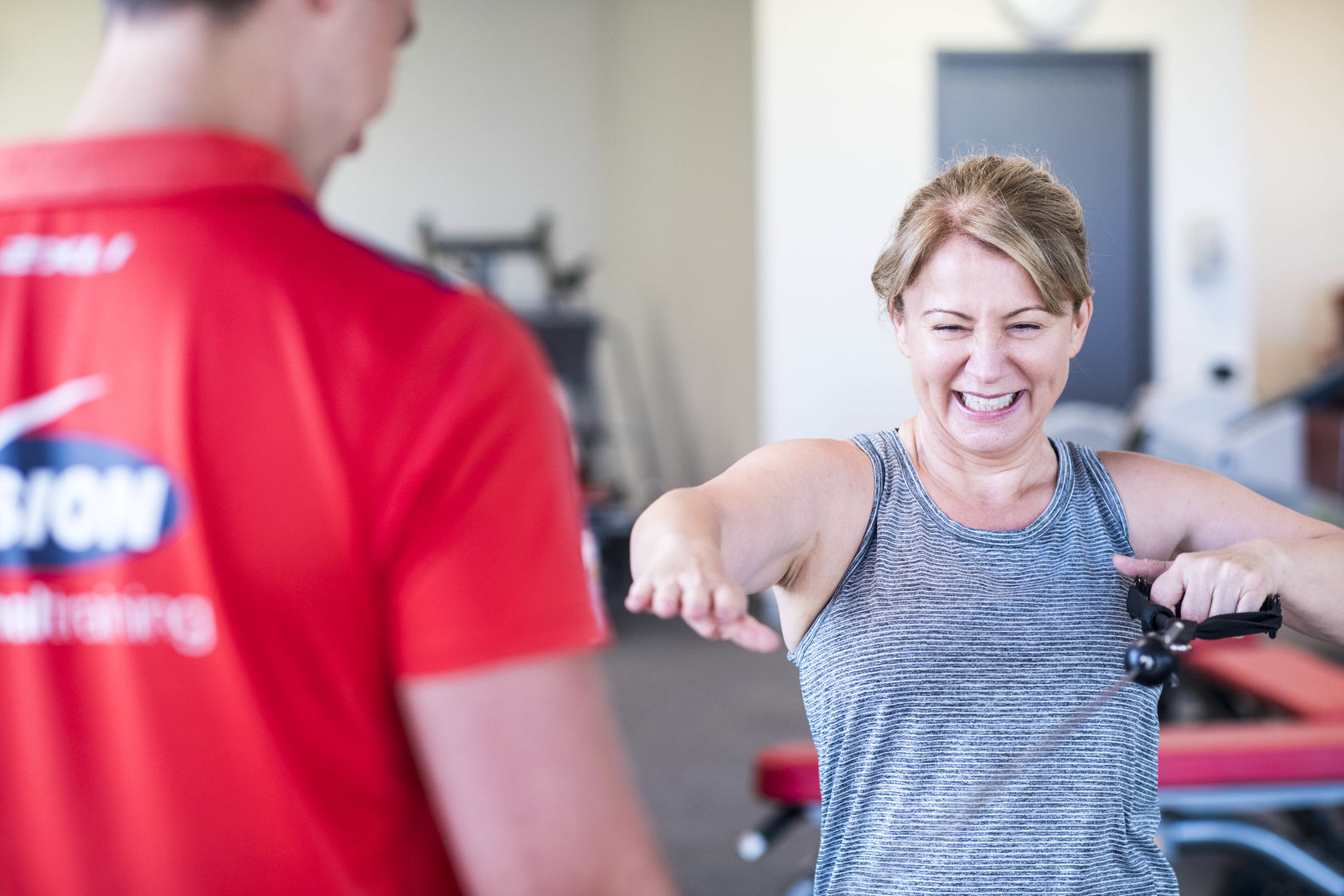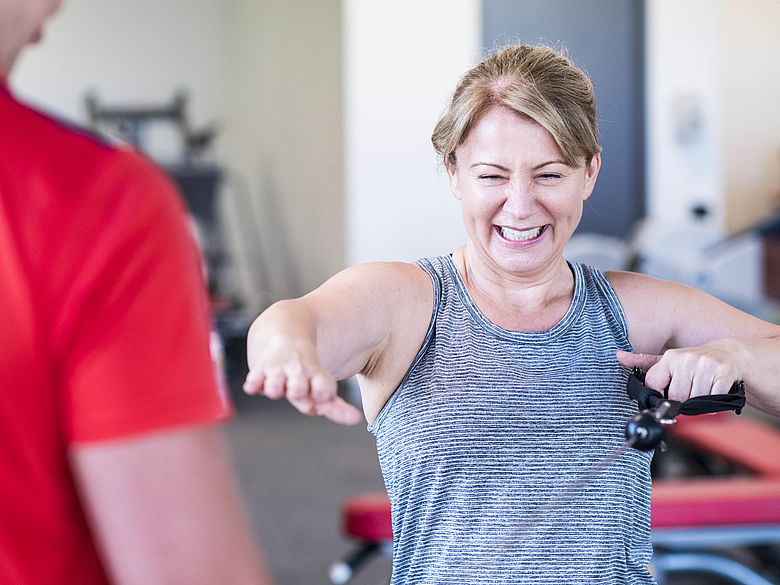Getting started
A well-proven strategy for absolute beginners is a run/walk program, which is to say a session that alternates periods of running and walking. You might well start out walking more than you run. A typical 10-week program based on 2-3 30-minutes sessions a week might look like this:
Week 1: 2 minutes running/4 minutes walking X 5
Week 2: 3 minutes running/3 minutes walking X 5
Week 3: 4 minutes running/2 minutes walking X 5
Week 4: 5 minutes running/3 minutes walking X 3
Week 5: 7 minutes running/3 minutes walking X 3
Week 6: 8 minutes running/2 minutes walking X 3
Week 7: 9 minutes running/1 minute walking X 3
Week 8: 13 minutes running/2 minutes walking X 2
Week 9: 14 minutes running/1 minute walking X 2
Week 10: Run for 30 minutes!
A sports field is an ideal place to start, but to be honest any safe route will do.
For someone who's already training but not running, a good first step is to start with sessions that incorporate intervals of running into a mixed workout. Many parks and open spaces now feature adult exercise equipment and you can introduce running as one element in a mixed circuit session: simply alternate one or more exercises with intervals of running. As your fitness improves, add more exercises, more repetitions, more metres run between exercises, and more circuits of the whole set of equipment provided.
Getting quicker
Once you have mastered steady running for 30 minutes, you can think about improving your pace. Tools for this include pacing, intervals and fartlek.
Pacing (or striding) is a type of running session where, instead of running at a steady speed, a section of moderately hard effort is sandwiched between an easier 'warm-up' and 'warm-down' section. The hard section would be fast enough that any speech beyond monosyllables becomes difficult. In the context of a 30-minutes session, this could spilt down into
Warm-up: 5 minutes
Hard section: 20 minutes
Warm-down: 5 minutes
With intervals, you plan a course with sections of known length. Serious athletes often use a running track. You then alternate fast and slow-paced sections according to a plan, e.g. 3 * 400m medium-fast, alternated with 3 * 200m jog.
Fartleks are unstructured or less-structured intervals. You might repeat laps of 400-800m that include up and down gradients and/or different types of running surface: you might select one section for a flat-out sprint, a couple of sections for different grades of medium to hard running, and space them all out with sections of jogging: or you might go running with a group and take turns to set the pace. Either way you will vary the pace continually.
Most people find any kind of speed training makes for a challenging session, but it is essential if you are to really progress as a runner and fulfil your potential. It is best to start this quite early in any race preparation process, so that as you work on your other training objectives such as stamina, you are beginning to use your new speed. Typically, you would concentrate most of your speed training (1-2 sessions a week) in the first half of your race preparation. You would peg it back to one session every 1-2 weeks in the later stages.
Going further
Once you have mastered runs of 4-5km - your basic 30-minute session - running longer distances comes quite naturally. Most published training plans for long-distance races will include one LSD (long slow distance) run per week, gradually increasing in length as the plan progresses. The aim of the LSD run is to stay within a comfortable pace but keep pushing the envelope in terms of distance: you will then find that all your runs can get longer as training progresses.
As speed training is concentrated in the early stages, distance training will be focused on the later part of preparation for longer races.
Hills
Even if you plan to compete or to do most of your running on the flat, there is a lot of value in training on hills. You can add intensity to your workout without running any further or faster, so it's a great training opportunity for the time-poor. It will make you a stronger runner. If you are competitive-minded, attacking on the uphill is a powerful statement that can intimidate rivals!
For those undertaking higher weekly training mileage, including a mixture of gradients in your training can actually help reduce injury risk, because you are not constantly putting loads and impacts through your joints at the same angles.
In terms of technique, when going uphill you should lift your knees a little higher, strike the ground more with the forefoot than the midfoot, and use the arms more forcefully - in effect, move to a slightly more sprint-like running action. When going downhill, focus on striding out longer and striking the ground more towards the heel.
For the average runner, including hills in one run per week is a sensible goal.
Variety
We've already covered speed training, distance and hills as elements that should be included in a running program each week: this alone implies a certain amount of variety in your training. Much of the pleasure of running comes from getting outdoors and visiting the most pleasant locations you can find. Here in the Eastern suburbs we're spoilt for choice, whether you favour the harbourside, the clifftops on the ocean side, Bondi Beach or Centennial Park. Enjoy your local amenities and keep it as varied as possible!
A note on weather
As we come into winter, you may ask, isn't it better to stick to the treadmill, where everything, but particularly the weather, is under my control?
The answer is that some people will be happier on the treadmill, some of the time. Sometimes it's nice just to run without having a preselected pace or distance beyond getting back home at the end of the run.
With a little practice, most of the time you can pick a dry patch for a run even on a rainy day using the weather radar animation available on bom.gov.au, based on real-time radar images taken at 5-minute intervals. In Sydney, surprisingly few days in the year have a full 24 hours of continuous rain!
What equipment do I need?
Shoes: most likely, the most expensive item. You should absolutely buy shoes with an element of shock absorption (especially in the heels for heel-striking runners). No Converse! No Dunlop Green Flash! Athlete's Foot stores use a machine to analyse your gait and recommend a suitable brand and model. Designs change from year to year but it's mostly cosmetic: a running shoe is a padded sole with a breathable synthetic upper and should be comfortable from the first moment you put it on.
Socks: another surprisingly expensive item. Modern running socks are seamless, padded, sweat-wicking affairs which have actually advanced quite a lot over recent years. It varies from person to person, but if you want to avoid blisters, avoid doing heavy mileage in cheap cotton socks with seams at the toe.
Shorts and singlet: the go-to for summer running. Singlets are less restrictive of arm movement than tee-shirts are. Modern synthetics like polyester microfibre will wick sweat away quite effectively and allow it to evaporate quickly.
Hats: lightweight peaked cap for summer, beanie for winter (especially for bald guys)!
Winter gear: for running in Sydney, you are unlikely to need any really heavy gear. The following are useful: a long-sleeved lightweight breathable polyester top for a foundation layer; a single-layer ultra-lightweight polyester shell jacket that can scrunch up into your shorts pocket; leggings and a lined trackie top for the coldest days.
Precautions for longer runs
Vaseline! Blisters and chafing can be a painful nuisance on longer runs. Vaseline the feet before putting socks on and pay particular attention to: balls of feet, toes, spaces between toes and the outside edge of the sole. Other areas (sorry for mentioning!): groin, nipples, bit just below the armpit where the arm can rub, and if carrying a backpack, the bit just below the back of your shorts waistband.
Cramps: Cramps can occur in the later stages of a really long run such as a half or full marathon or, more commonly, either immediately afterwards or later (often at night). They most often affect the quadriceps, hamstrings, and gastrocnemius/soleus (calf) muscles. Cramps are often a sign of undertraining: you have not done enough to acclimatise your body to the demands you are placing on it.
If you cramp during a run your body will clearly tell you to stop and, if possible, stretch. Hopefully you will be able to continue afterwards. You can reduce the risk and severity of cramps by drinking appropriate amounts of water and electrolytes before and during the event - remembering that on a long run on a hot day you will lose surprising amounts of both. Ultra-marathoners can lose several kilograms in a race unless they rehydrate appropriately.
You can buy magnesium supplements to take regularly in order to reduce the risk and severity of cramp.
A note on stitch
Although most runners will experience a stitch at some point, there is no real consensus on what causes it. A stabbing pain at the lower edge of the ribcage, it most commonly affects the right side and sometimes causes pain near the tip of the shoulder blade, sometimes in the shoulders themselves. Some think it is caused by cramping of the diaphragm, or irritation of the muscles of the abdominal wall. Another theory is that it is caused by increased blood pressure in certain internal organs, chiefly the liver and spleen, occasioned by exercise and exacerbated by jarring.
Suggested treatments include exhaling when landing on the opposite side foot to the stitch itself, or stretching the affected side while applying firm hand pressure to the site of the pain.
After running: static stretching
Be sure to stretch out your calf, hamstring and quads with some basic stretches after every run!
And finally…
If you train consistently and stay just within your limits, you will see improvements over time. Please try to overcome the occasional urge to push too hard - this may well end in tears, metaphorically or literally. Have fun exploring your new capabilities.
Happy running!
*Disclaimer: Individual results vary based on agreed goals. Click here for details.

